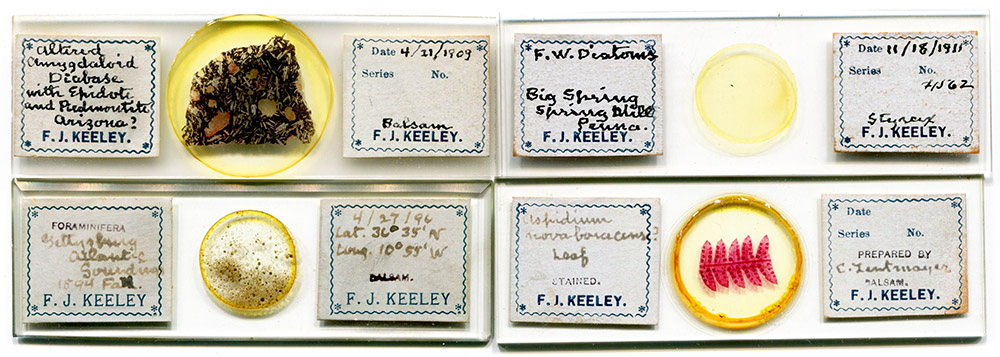
Figure 1. Microscope slides that were prepared by F.J. Keeley, dated 1886 through 1911. Although best known for his preparations of minerals and diatoms, Keeley mounted a variety of other objects, including foraminifera and botanical specimens.
Franklin James Keeley, 1868 - 1949
by Brian Stevenson
last updated August, 2024
Frank J. Keeley was an important American authority on geology, diatoms, and the use of microscopes. He was an active member and officer of the Biological & Microscopical and the Mineralogical & Geological Sections of the Academy of Natural Sciences of Philadelphia, and long-term curator of the Academy’s mineral and diatom collections. An obituary from his colleagues at the Academy noted that “His particular interest lay in the field of microscopical objects - minerals, and diatoms. … During his lifetime he accumulated what is thought to have been the finest collection of micro-minerals in the World. His work on the structure of the diatom wall is considered today the most authoritative in the field. He assembled a large collection of microscopes, and he was a Fellow of the Royal Microscopical Society of London” and “was one of the few great general naturalists left in this country”.
Microscope slides by F.J. Keeley are uniformly of very high quality, and encompass a breadth of specimen types (Figures 1 and 2). Other makers’ slides that were once part of Keeley’s collection are occasionally seen, and can be identified by his name stamped with ink (Figure 3).

Figure 1.
Microscope slides that were prepared by F.J. Keeley, dated 1886 through 1911. Although best known for his preparations of minerals and diatoms, Keeley mounted a variety of other objects, including foraminifera and botanical specimens.
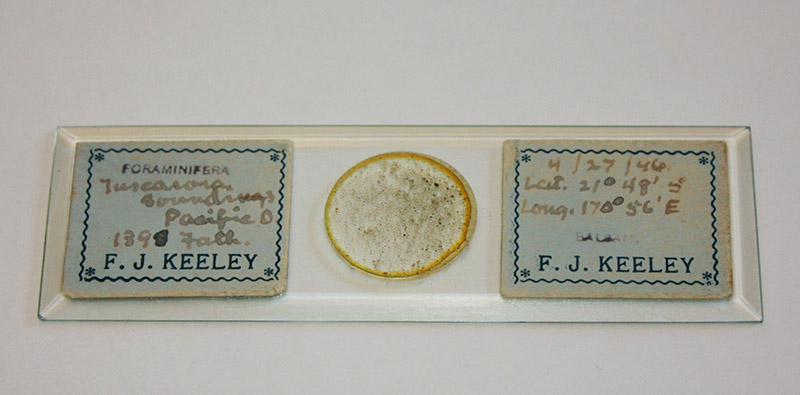
Figure 2.
Keeley occasionally used thick glass slides with beveled edges, which give the mounts an elegant look. The date on this slide appears to be April 27, 1896. Another foraminifera mount on this type of slide, and with the same date, is shown in Figure 1, lower left corner.
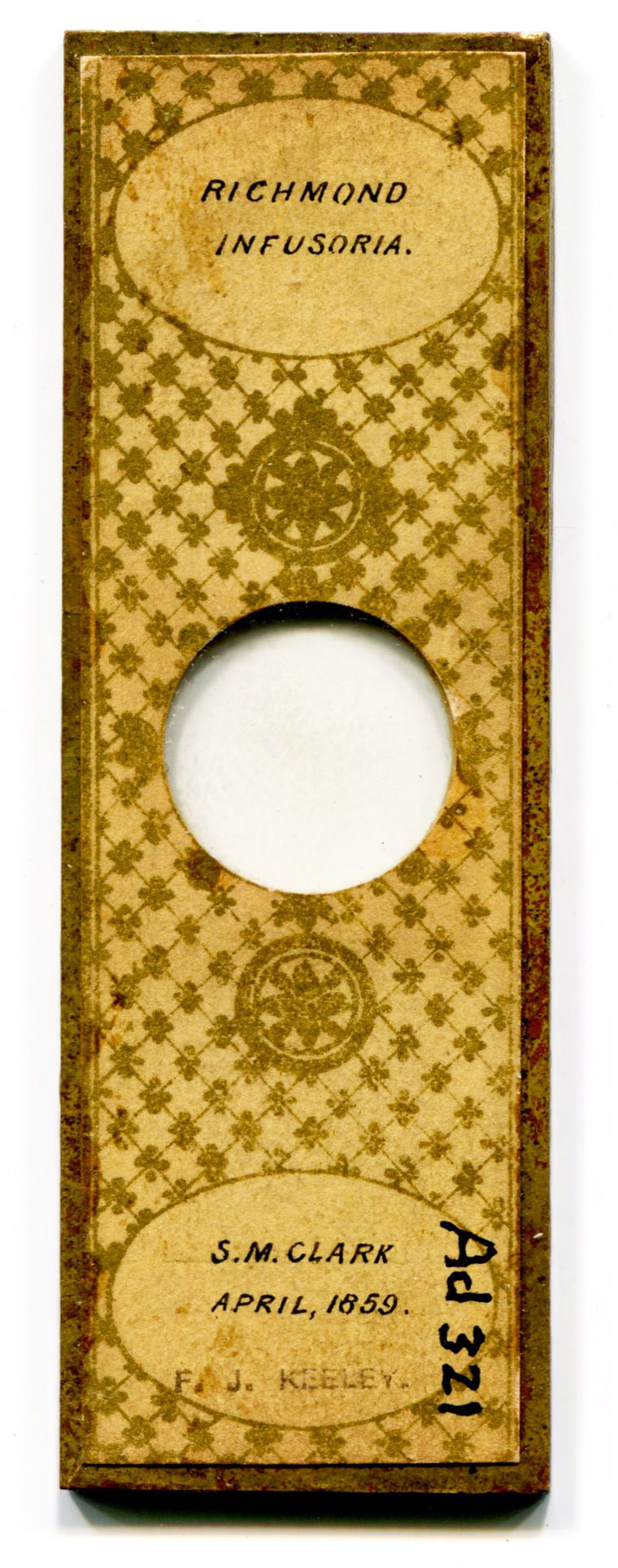
Figure 3.
A number of slides are known that bear Keeley’s name stamped in ink, such as this microscope slide of diatoms, prepared in 1859 by Spencer Morton Clark (1811-1890).
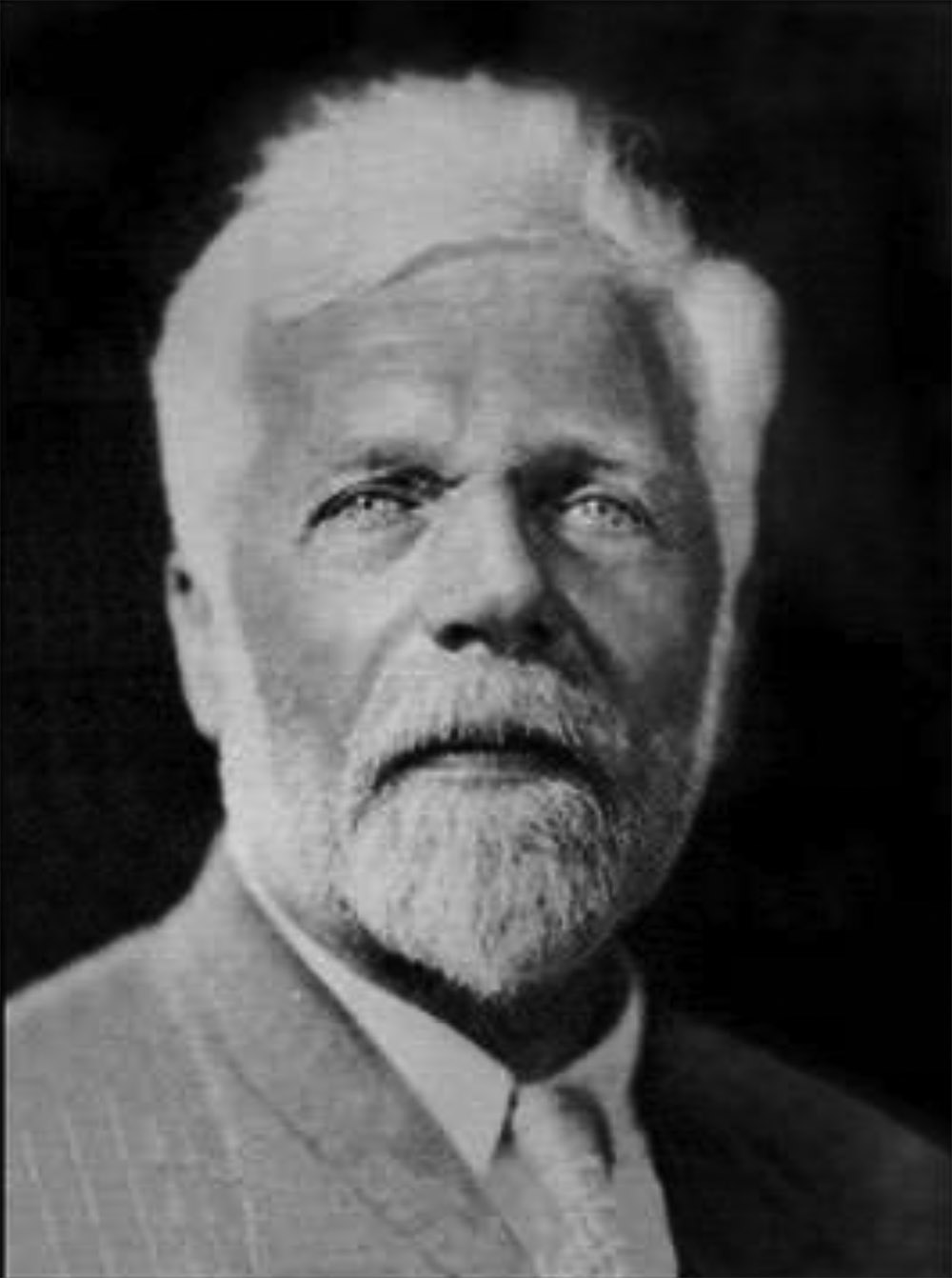
Figure 4.
An undated photograph of Frank J. Keeley.
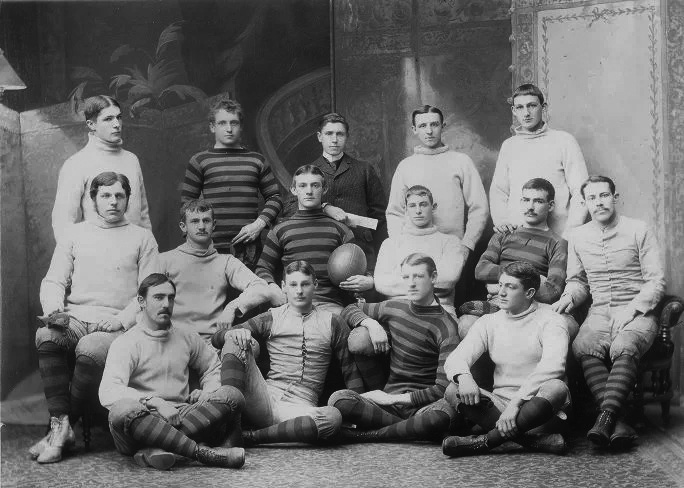
Figure 5.
The 1887 University of Pennsylvania football team, which included Frank Keeley. It is not certain which of these men is Keeley. Adapted for nonprofit, educational purposes from https://archives.upenn.edu/exhibits/penn-history/football/teams/team-1887
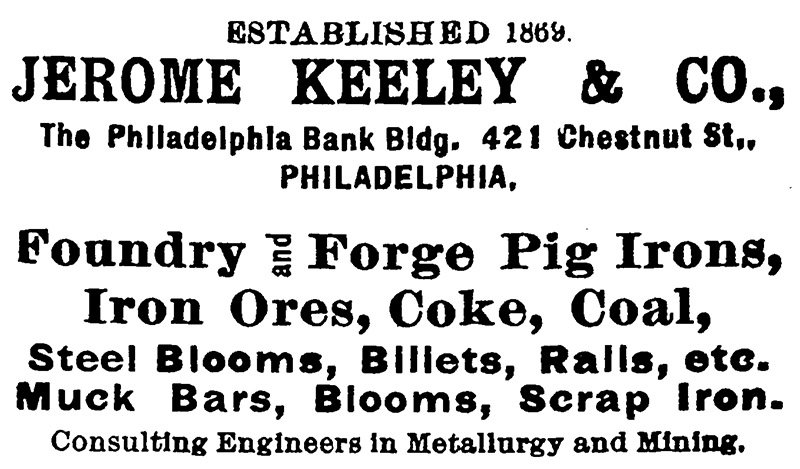
Figure 6.
An 1898 advertisement for Frank Keeley’s business, which was a partnership with his father, Jerome. Frank’s grandfather, Davis Keeley, had built and operated iron-producing furnaces.
Franklin James Keeley was born in Philadelphia, Pennsylvania on January 6, 1868. He was the eldest of three children of Jerome and Kate Ida (nee Hoffman) Keeley.
Father Jerome operated a iron forging business (Figure 6). Frank joined the business in 1892, after graduating with bachelors and masters degrees from the University of Pennsylvania.
Frank Keeley never married, but lived throughout his life with his parents, and later, an unmarried sister.
He joined the Academy of Natural Sciences of Philadelphia (A.N.S.P.) in 1894.
Keeley took an early interest in the composition of diatoms, especially their internal structures. In a 1901 publication in The American Monthly Microscopical Journal, he discussed microscopic examination of broken diatom valves, which reveals their interiors, and how difficulties with resolving the interiors of Aulacodiscus species were solved by alternatively soaking diatoms in fluids of varying refractive indices.
Later that year he gave presentations to the A.N.S.P. on the “Development of the American microscope … rock-inclusions, various appliances of the microscope, and the Abbe diffraction theory”.
Keeley elaborated on his methods for investigating diatoms in this 1903 report:
“Mounting broken valves on edge so as to obtain a sectional view, and mounting in a manner that permitted of successively immersing the forms in media of varying refraction indices.The present method consists in depositing on the diatoms a thin film of silver, using the solution ordinarily employed for silvering mirrors, which, if dropped on the cover-glass containing the diatoms, will silver the latter to a considerable extent before any appreciable quantity of the metal is deposited on the glass. The finer the irregularities on the surface the heavier will be the deposit of silver, and the best results are obtained on gatherings containing broken and corroded forms, separated plates, etc., the structure of which becomes quite apparent. Thus conclusions can be drawn as to the correct nature of a complete and perfect valve which will be more accurate than when it is itself examined, particularly if the markings are fine, when they become filled with silver.
Under favorable conditions, after mounting in balsam and examining by transmitted light, valves or portions of them may be found having the appearance of plates of perforated metal, and while the results so far have principally been corroborative of those obtained by previous methods, some features not distinguishable under ordinary conditions are rendered apparent, among which may be mentioned a ring of processes near the margin of the valve of Coscinodiscus subtilis, which extends toward the interior of the frustule.
The character of the raphe is particularly well displayed in Navicula and its allies, as well as the small channels in the central and terminal nodules, which doubtless have some function in connection with the protoplasmic currents causing the motion of diatoms. In Navicula rhomboides it becomes apparent that the raphe is single as in other species of this genus, and that the double raphe, based on which this form has been placed in a separate genus, is an optical illusion.
This process differs from that by which the late A.Y. Moore plated diatoms, as his were covered with a heavy layer of silver or gold and examined as opaque objects. It is rather a staining process, but likewise differs from the methods of Moore and others in this direction, which filled the cavities in the valves with opaque matter, while in this case the silica itself is rendered opaque, or nearly so.
As in all microscopical investigation, it is necessary to use judgment in interpreting appearances seen, as they will vary materially in the same species, depending, on whether the entire structure is preserved. Isthmia affords an excellent example. Some valves may be found in which the coarse markings appear as holes in the blackened silica, showing that the secondary structure is entirely gone. Others will show the secondary structure in a similar manner as holes in a darkened plate, but still others will have the large oval markings entirely covered with a film of silver, indicating that there is a still finer and ordinarily invisible ‘tertiary structure’ or plate, which serves as a basis on which the silver is deposited. Exactly the same conditions may be noted on the external plate of Coscinodiscus asteromphalus, but there is never an indication that the eye-spots on the inner plate are anything but clear openings.”
By 1904, Keeley was Conservator of the collections of both the Biological & Microscopical Section and the Mineralogical & Geological Section of the A.N.S.P.
Keeley was elected as a Fellow of the Royal Microscopical Society in 1910.
In 1926, Keeley made a presentation to the Philadelphia Mineralogical Society on "Microscopic mineralogy and the George W. Fiss collection", which was summarized, “Early in the 1880's minerals were first mounted for display under the microscope, by Mr. Fiss and possibly also Mr. Rakestraw, working independently. The speaker's long association with Mr. Fiss enabled him to give a particularly interesting and intimate description of the manner in which the Fiss collection was brought together and the personalities involved in it. Today the Fiss collection is probably the finest collection of microscopic minerals in existence. Mr. Keeley also reported the results of his observations with the microspectroscope.” An illustrated essay on the life and microscopical works of G.W. Fiss can be read elsewhere on this site.
Marina Potapova wrote, “From the beginning of the twentieth century to 1927 the most active worker in diatoms at the Academy was Charles S. Boyer (1856-1928), a school administrator (Reimer et al., 1991). He too was in active correspondence and exchange of materials with other diatomists and, as his two predecessors, accumulated a large collection of his own which was also added to the Academy's holdings. His most significant work was the publication of ‘Synopsis of the North American Diatomaceae’, (1927) the first such account for North America. During his tenure at the Academy there were two other persons who were extremely interested in diatoms and who contributed in specimens, in time, and in money to the collection; these men were Dr. Thomas Stewart and Mr. Frank Keeley. T. Chalkley Palmer, a president of the Academy, also made contributions. After the death of Mr. Boyer in 1928, work on the diatoms at the Academy was principally under the care of Mr. Frank Keeley who was an avid curator of materials.”
Keeley moved to Edgewater, Florida in the late 1920s, along with his widowed mother and unmarried sister Marie. The 1930 census stated that Frank did not then have an occupation, implying that he had retired from the iron production trade. The 1940 census found Frank and Marie back in Pennsylvania.
Frank J. Keeley died on April 12, 1949 of prostate cancer. His death record stated that he was “retired Curator of the Academy of Natural Sciences”, which seems indicate that he held his scientific work to have been more important than his occupation in the iron trade.
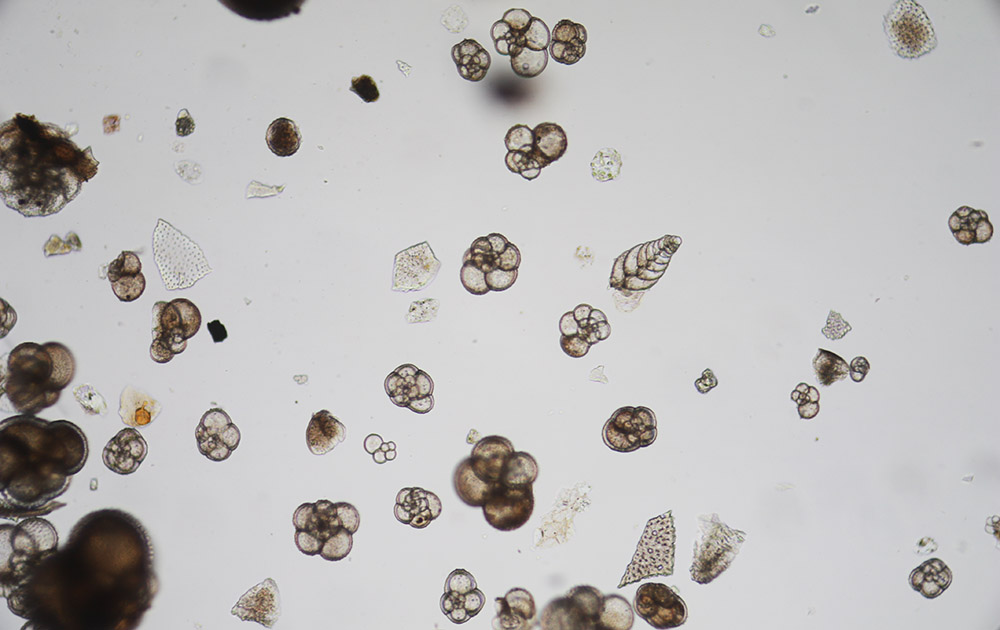
Figure 7.
Soundings from the Atlantic Ocean, mounted by Frank J. Keeley on April 27, 1896 (see Figure 1). Keeley wrote "Gettysburg, Atlantic soundings, 1894 fathoms ... Lat. 36° 35' N, Long. 10° 55' W"; that location is along the Gorringe Ridge, off the south-western coast of Portugal, which the U.S.S. Gettysburg surveyed in 1876. That ship was decommissioned in 1879. Imaged with a 10x objective lens and C-mounted digital SLR camera on a Leitz Ortholux II microscope.
Resources
The American Mineralogist (1926) Philadelphia Mineralogical Society, page 32
https://archives.upenn.edu/exhibits/penn-history/football/teams/team-1887 (accessed August, 2024)
General Alumni Catalogue of the University of Pennsylvania (1917) “Frank J. Keeley, B. S.. 1887; E. M., 1888; mem. football team, Mining and Metallurgical Engineer; mem. council, Acad. Natural Sciences, Phila.; curator William S. Vaux collection. Merion Station P. O., Pa.”, page 111
The Iron Age (1898) Advertisement from Jerome Keeley and Co., multiple issues
The Iron Age (1905) Obituary of Davis Keeley, “long a prominent furnace manager, most of the time in Eastern Pennsylvania, died at Phoenixville, Pa., January 18. He was born in 1820 and was therefore 84 years of age. In 1842 he was engaged in building pumps and mining machinery in Pottsville. In April, 1845, he made an agreement to do all the furnace building at the Phoenix Iron Works and built two large blast furnaces, besides a number of puddling furnaces. Subsequently he rebuilt one of the furnaces complete from floor to stack in three months, which at that time was considered a remarkable achievement. In 1879 he took charge of a furnace in Morris County, N. J., and equipped it for making a special quality of pig iron for nails and horseshoes. In 1881 he remodeled two blast furnaces in Albany, N. Y., after which he remodeled those of the Merion Iron Company at Conshohocken, Pa. His next work in that line was to remodel the Hooven furnace at Norristown, Pa., his last work being on the Edge Hill furnace at Edge Hill. Pa., after which, in 1888, he retired from active business. His son Jerome Keeley and his grandson Frank J. Keeley conduct a pig iron business at 435 Chestnut street, Philadelphia, under the firm name of Jerome Keeley & Co.”, page 477
Journal of the Royal Microscopical Society (1921) Fellows, “1910, Keeley, Frank J., B.S., E.M., Member of the Council, Academy of Natural Sciences, Philadelphia; Vice-Director, Mineralogical Section, Academy of Natural Sciences, Philadelphia. Box 25, Merion Station, Penna, U.S.A.”
Keeley, Frank J. (1901) Structure of diatoms, The American Monthly Microscopical Journal, pages 273-275
Keeley, Frank J. (1903) Preparation of diatoms, Proceedings of the Academy of Natural Sciences of Philadelphia, pages 2-3
Keeley, Frank J. (1913) Eggs of a mite in empty capsules of Orthotrichum pusillum, The Bryologist, pages 18-19
Keeley, Frank J. (1914) Notes on some igneous rocks at Ogunquit, Maine, and Pigeon Cove, Mass., Proceedings of the Academy of Natural Sciences of Philadelphia, pages 3-8
Keeley, Frank J. (1925) Pleurosigma boyeri: a new diatom from Florida, Proceedings of the Academy of Natural Sciences of Philadelphia, pages 31-32
Potapova, Marina (2010) The ANSP Diatom Herbarium: an important resource for diatom research, Proceedings of the Academy of Natural Sciences of Philadelphia, Vol. 160, pages 3-12
Potapova, Marina (accessed August, 2024) History of the Diatom Herbarium, https://ansp.org/research/systematics-evolution/diatom-herbarium/diatoms-history
Proceedings of the Academy of Natural Sciences of Philadelphia (1901) Report of the Biological and Microscopical Section, page 769
Proceedings of the Academy of Natural Sciences of Philadelphia (1904) Report of the Biological and Microscopical Section, pages 849-850
Proceedings of the Academy of Natural Sciences of Philadelphia (1904) Report of the Mineralogical and Geological Section, pages 848-849
Proceedings of the Academy of Natural Sciences of Philadelphia (1949) Frank James Keeley, Vol. 101, page 345
US census and other records, accessed through ancestry.com